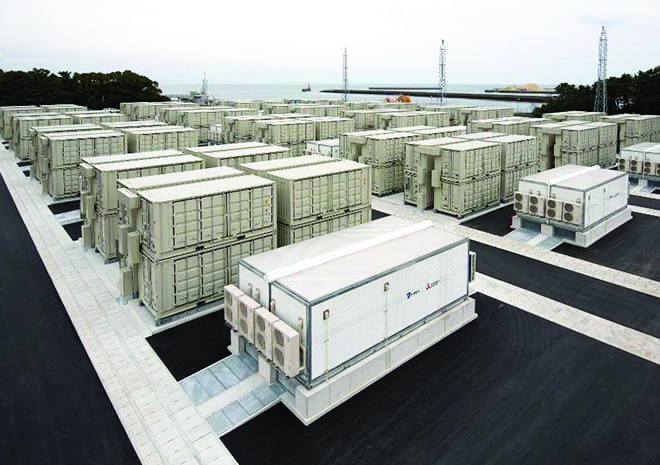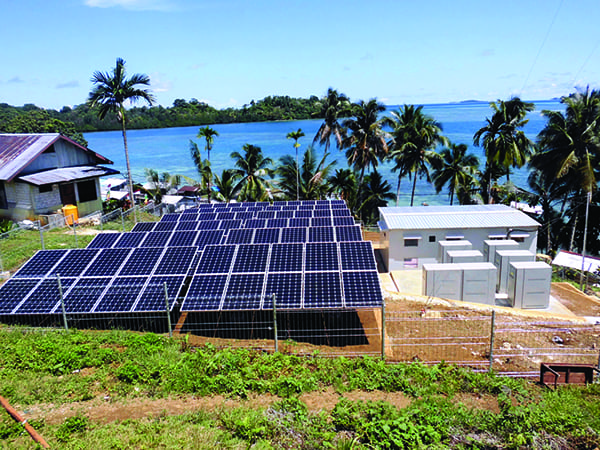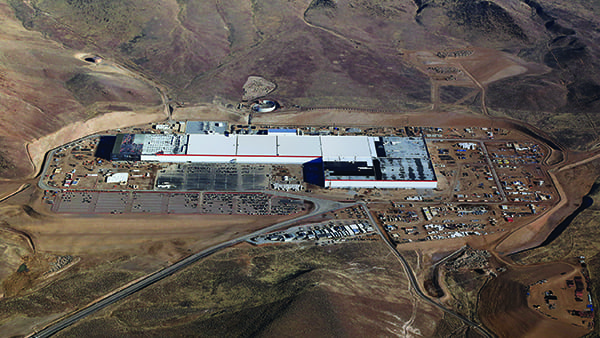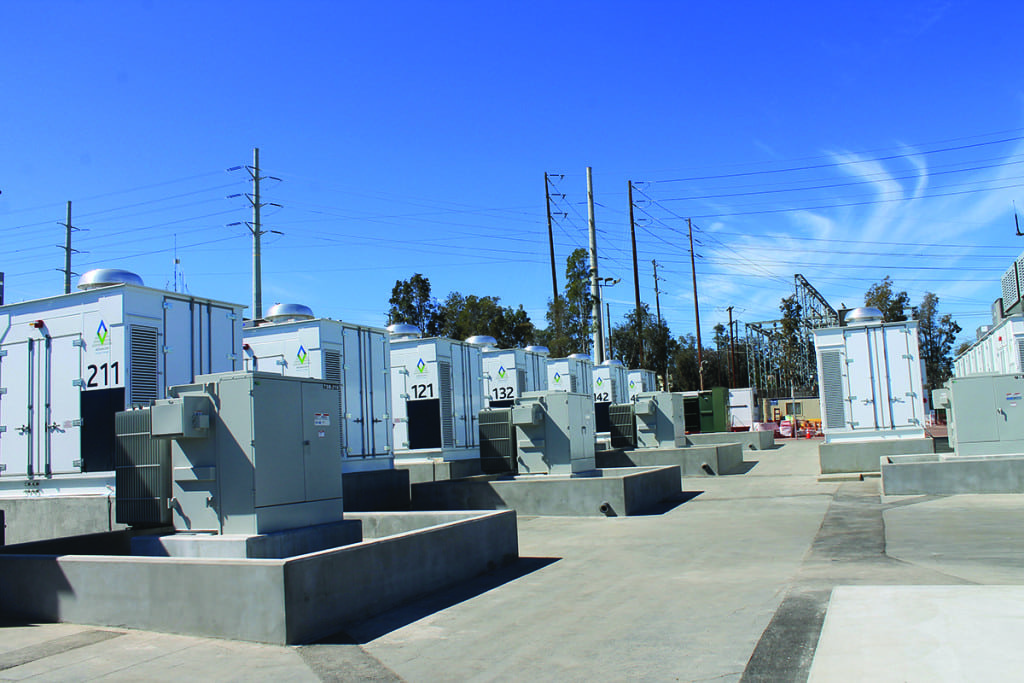Grid-connected batteries have long been touted as a tantalizing prospect that could help balance electricity supply and demand as the amount of installed variable renewable generation ramps up. New developments suggest that prospect is now a reality.
Energy storage using grid-connected electrochemical battery systems has widely been hailed as a crucial tool to enable widespread integration of renewables, unlock grid flexibility, and bolster grid reliability. For years, battery storage was considered elusive, hindered by high upfront costs and technical setbacks. But over the past decade, battery storage has taken great leaps toward mainstream use, expanding exponentially alongside renewable technologies.
In the U.S., which harbors substantial reserves of pumped hydropower storage, battery storage is now clearly an established market. Battery storage deployments—including from lithium-ion, lead acid, sodium chemistries, and flow technologies—grew to 336 MWh in 2016, doubling megawatt-hours deployed in 2015, according a report released by GTM Research and the Energy Storage Association (ESA) in the first quarter of 2017. The entities remarked that in the final quarter of 2016 alone, 230 MWh came online—more than the sum of the previous 12 quarters combined—driven by a burst in utility installations (Figure 1).
 |
| 1. U.S. energy storage deployments (MWh). Source: GTM Research/ESA (U.S. Energy Storage Monitor) |
Worldwide, as of early April, about 733 grid-connected electrochemical projects with a total rated power of 1.8 GW (of varying duration) have been installed, according to the U.S. Department of Energy’s Global Energy Storage Database.
A Global Factor
While a vast amount of research and analyses on the sector exists, the consensus is this growth is expected to continue. IHS Markit, which owns the Energy Storage Intelligence Service, records a global 390-MW pipeline for battery projects, characterized by new announcements in China, Australia, South Korea, and India.
“Energy storage is set to grow as fast as solar photovoltaic energy has in recent years, sparking strong interest from a wide range of players and underscored by recent mergers and acquisitions among car manufacturers, major oil and gas companies, and conventional power suppliers,” said Marianne Boust, a principal analyst at IHS Markit.
Industry experts caution, though, that this growth won’t be even. Several fundamental contributing factors are setting the stage for future battery storage growth in different regions. Every country around the world, they note, has a unique energy storage potential that is based on the combination of energy resources, historical physical infrastructure, and electricity market structure, as well as regulatory framework, population demographics, energy demand patterns and trends, and general grid architecture and condition.
It is more valuable to assess general drivers affecting the sector, the experts say. One of the most important drivers of utility-scale battery storage systems, for example, continues to be the substantial growth in the amount of renewable energy being deployed around the world. Bloomberg New Energy Finance said in a 2016-released long-term forecast that 644 GW of new wind and solar photovoltaic (PV) capacity could be installed worldwide over the next five years. That variable generation could present a host of challenges to electrical grids not designed to handle them, particularly in the developing world, where grids are already stressed delivering existing generation.
Another key driver will involve national targets to curb greenhouse gas emissions under the Paris Agreement negotiated by 197 countries in late 2015. Countries are also generally moving toward improving the resilience of their grids in the face of heightened climate disruptions.
Meanwhile, falling system costs are making battery storage an attractive alternative to certain infrastructure investments. The sector’s relative maturity is also prompting many utilities to consider energy storage systems in resource planning. The financial community, too, is getting comfortable with investments in battery storage.
In the Act of Consolidating
Yet, the sector is still in a state of flux, and it is still unclear whether this will help or hinder the widespread deployment of battery storage.
Surging interest and rapid deployment have attracted an increasing number of actors in the sector, such as utilities, battery manufacturers, and renewable project developers, which are generally helping to drive competition. Greensmith Energy, a U.S.-based firm that designs and deploys energy storage systems and software, noted that in the face of diminished venture capital funding, market participants are also looking to execute on growth strategies and scale-up to maximize profits or decrease costs along the value chain.
Those are some reasons the sector saw multiple large corporate deals during 2016. Total Energy, for example, acquired industrial battery maker Saft, Engie bought Green Charge Networks, Doosan struck an agreement with energy storage systems software provider 1Energy Systems, and Tesla Motors acquired SolarCity.
“Under synergistic circumstances, mergers can certainly jumpstart long-term growth for an enterprise, but the failure rate of mergers and acquisitions is between 70%–90%,” said Ian McClenny, a research analyst with Navigant Research in an August blog post.
McClenny pointed out that enterprises might also choose to acquire companies to fundamentally shift their core competencies to another business segment.
“Creating shareholder value is important to secure longevity in any market; investor expectations help incent company innovation,” he said. “Key motivations behind these acquisitions appear to be project financing and accessibility to behind-the-meter customers. Having more financial resources bolsters a storage company’s influence when bidding for larger grid storage contracts.”
A Technology Shakeout
Meanwhile, over the past three years, battery storage technology markets have seen a general upheaval.
David Hart and Alfred Sarkissian from the Schar School of Policy and Government at George Mason University note that battery technology has followed a diffusion pathway that is characteristic of rapidly growing industries. In the U.S., between 1990 and 2009, battery chemistry or application showed no specific trend. Backed by state research and development, and commercialization programs, such as in New York and California, fewer than 10 projects that were larger than 250 kW came to fruition. Most used sodium-based battery technologies, followed by lead-acid and then nickel-based technologies.
It wasn’t until 2009 that A123 Systems and AES began commercial operation of the first 12-MW/4-MWh lithium-ion battery system for a spinning reserve project at AES Gener’s Los Andes substation in Chile’s Atacama Desert. That year, AES also started up an 8-MW lithium-ion frequency regulation project at a generation plant in Johnson City, N.Y., a project that was the first of its kind to be classified as a generator by the U.S. Federal Energy Regulatory Commission (FERC).
The Battery Pack
Lithium-ion and lead-acid battery technologies contended for dominant market share between 2011 and 2014, a period that also ushered in commercial use of the first flow battery. The U.S. Department of Energy noted that most battery systems installed during that period were used for renewables capacity firming, electric energy time shifting, frequency regulation, and electric bill management. Notable projects that came online during that period were Duke Energy’s 36-MW advanced lead-acid Notrees Wind Storage Demonstration Project in Goldsmith, Texas, a project that sought to optimize energy delivery from an adjacent 153-MW wind farm. AES also started up the Laurel Mountain Project in West Virginia. Rated at 32 MW/8 MWh, that lithium-ion project was sited with a 98-MW wind farm, providing frequency regulation and ramping services to PJM.
Then, two years ago, grid-scale battery systems began to see a more intense period of growth. About 145 MW of lithium-ion projects came online in the U.S. alone in 2015—four times the rated power from lithium-ion systems in any prior year and more than what was added during the entire period between 2009 and 2014—boosted by private financing and fostered by PJM’s now-established frequency regulation services.
Lithium-ion batteries still dominate markets in the U.S. and around the world. GTM Research noted that for the entirety of 2016, lithium-ion batteries held a U.S. market share of about 97% or greater, driven in large part by “massive declines in lithium-ion battery prices and growing acceptance of the technology’s bankability, leading to lithium-ion batteries’ implementation in the majority of large utility-scale projects throughout the year,” the research group said. “This trend is expected to continue, as numerous megawatt-scale procurements were awarded in 2016 to developers implementing lithium-ion technology; these projects are expected to come on-line over the next three to five years.”
Global technology research company Technavio last year suggested that the growing demand for electricity storage could fuel a similar boom worldwide for lithium-ion batteries, projecting that the segment could surpass 3,130 MW by 2020.
Meanwhile, in 2016, lead-acid battery technologies snagged a 1.6% share of installed U.S. battery storage capacity. Technavio suggests that this technology, conceived in the 1960s, will also see significant growth, reaching 990 MW worldwide by 2020. Technology innovations have helped lead-acid batteries achieve increased efficiency and overcome challenges such as slow charging. At the same time, the abundance of available raw materials for lead-acid batteries has increased the number of installations of the battery, said Sayani Roy, an industry expert at Technavio. However, future growth may be tempered by the technology’s short operational lifetime, which only spans on average between three and four years, as well by high maintenance requirements. Additionally, it will face stiff pricing competition from lithium-ion-based systems.
The sodium sulfur (NaS) battery segment is generally expected to do better, growing to 1,450 MW worldwide by 2020. NaS batteries, first developed in 1966 by Ford Motors, offer high energy density compared to other stationary storage batteries, and they can be compact.
Japan’s NGK Insulators in March 2016 built a 50-MW/300-MWh NaS storage system that was delivered to Kyushu Electric Power Co.’s Buzen Substation six months after it was ordered by Mitsubishi Electric Corp. The storage system consists of 252 NGK containerized NaS battery units, and it was installed on a site measuring about 14,000 square meters (Figure 2). One of the world’s largest stationary storage installations, the battery system is part of Kyushu’s demonstration to balance the grid using energy storage on Kyushu Island in southwestern Japan, where huge amounts of solar power have been installed following the 2012 introduction of a feed in tariff.
Costs for the technology are also continuously falling. “Also, its high energy density and operating temperatures along with the corrosive nature of sodium polysulfide make it suitable for large grid energy storage,” said Roy. Yet, as with lead-acid batteries, the segment will face competition from lithium-ion technologies, she noted.
Costs for flow batteries have also fallen and efficiencies have improved in recent years, but despite the hype surrounding this segment—they’ve long been touted as the logical choice for grid-scale applications because of their long durations and lifespans, and because they see less degradation from repeated charging cycles than other technologies—advances haven’t been broadly implemented in the field. Progress is on the horizon, however.
Primus Power recently announced that it has started production of its second-generation EnergyPod 2 flow battery, which it says has a five-hour duration, a 20-year lifespan, and costs 50% less than the leading conventional lithium-ion battery system. The company is shipping its battery systems to U.S. and international utilities, such as Puget Sound Energy in Washington.
At the same time, more companies are exploring the potential of flow battery systems. In March, for example, San Diego Gas and Electric (SDG&E) and Sumitomo Electric unveiled a 2-MW vanadium redox flow battery storage pilot project to test whether flow battery technology can economically enhance the delivery of power over the next four years.
Another battery technology that has flourished—but gets little attention despite its competitiveness with lithium-ion batteries—is zinc-air, a battery system that uses air for the cathode, and cheap, abundant zinc in the electrolyte. Arizona-based Fluidic Energy has deployed more than 100,000 zinc-air hybrid batteries in 10 countries, with applications spanning rural electrification and grid-reliability.
Fluidic’s initial commercial installation for Indonesian telecom customer Indosat has been online for over five years now, and since then, the company has expanded to rural electrification, taking the place of diesel gensets in island microgrids (Figure 3) that cannot connect to the national grid. The company is currently preparing to put up a battery system for Duke Energy in North Carolina that will serve a renewable energy microgrid at Great Smoky Mountains National Park.




